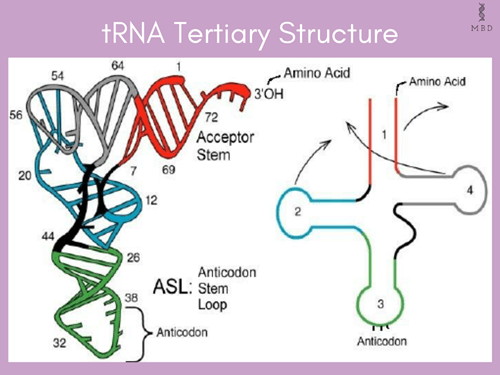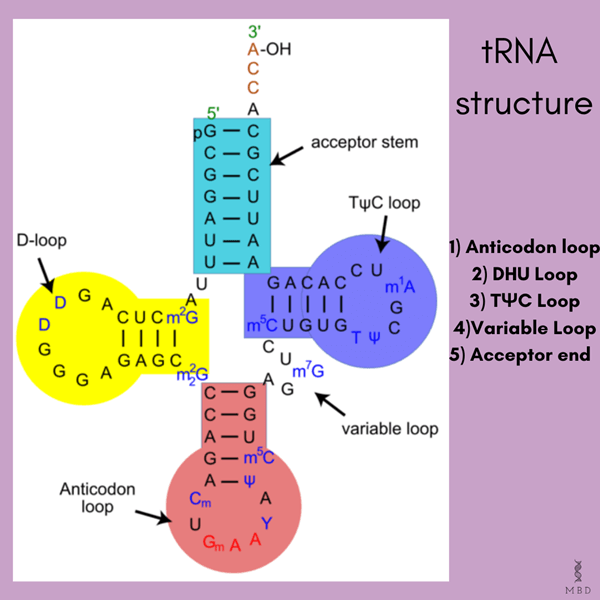Enthralling structure of tRNA (transfer RNA)

“Transfer RNA” from the name itself, one can have an idea about it. tRNA formerly known as soluble RNA or s-RNA is one of the three types of RNA molecules. It has a role in making a physical link between the messenger RNA and amino acid. tRNA generally has 70-90 nucleotides in length. It performs this function by transferring amino acids to the ribosome (the protein factory of the cell). tRNA is thus essential for translation (synthesis of protein by decoding of the genetic code). Let’s learn about the complicated structure of tRNA.
The RNA World referred to a hypothetical stage in the origin of life on Earth. -Sidney Altman
Table of Contents
Transfer RNA or tRNA – the adaptor molecule
Transfer ribonucleic acid (tRNA) helps to decode messenger RNA (mRNA) sequences to synthesize protein during the translation process. Amino acids, the building block of proteins do not have structural specialities to read the code and link it to an amino acid, Francis Crick then postulated about an adaptor molecule that read the code and would bind to specific amino acid single-handedly. Transfer RNA is the key link between transcribing RNA and translating that RNA into protein.
Structure of tRNA
tRNA typically has a polynucleotide chain of 70-90 nucleotides in length as mentioned above, it consists of an anticodon loop that has nucleotide bases complementary to the code (codon) of mRNA, it also has an amino acid acceptor end that binds to amino acids. There are usually specific tRNAs for specific amino acids, however, due to Wobble base pairing 45 tRNAs are there in total for 61 codons.
In the secondary structure, tRNA has a folded structure with three folds (hairpin loops) which form a shape like that of a leaf (three-leafed clover), one hairpin loop contains a sequence known as an anticodon. An anticodon recognizes and decodes an mRNA molecule, as each tRNA has its specific amino acid attached to its end. Another key point is that in the tertiary structure, tRNA is a compact molecule that looks like an inverted L. Thus the structure of tRNA can be classified into the primary, secondary, and tertiary structures.
Also read: Cell Biology Archives – My Biology Dictionary
The primary structure is a linear structure, secondary structures usually can be visualized as the cloverleaf structure, and the tertiary structure has an L-shaped 3D structure as it allows tRNA fits into the P and A site of the ribosome. To better understand the structure we can study various arms in different structures of tRNA.

Image Source: researchgate.net
-
Primary structure
- To begin with, tRNA’s primary structure is 70-90 nucleotides arranged in linear form.
- The bonds between these nucleotides are created post-transcriptionally.
-
Secondary structure
- The secondary structure of most tRNA consists of four helical stems cyan, blue, red, and yellow, as shown in the figure below.
- These are arranged in a cloverleaf structure to a central junction.
- This 2D structure then folds particularly into the 3-D tertiary structure.
- Another key point is that the acceptor arm has CCA sequence at the 3’end, amino acid gets attached at this end. DHU-loop serves as a recognition site for aminoacyl-tRNA synthetase. TΨC Loop is the recognition site of a ribosome. Variable Loop can potentially form an additional helix.

Image Source:proteopedia.org
-
Tertiary structure
- As the four arms in the secondary structure fold and join, they form an “L” shaped 3D tertiary structure.
- This structure has 2 arms, an acceptor arm on one end and the anticodon arm on the other end.
- The anticodon arm pairs with the complementary codon of mRNA.
- The two arms of the “L” are particularly formed by the stacking of the acceptor and TΨC-stem on one side, and of the anticodon and D-stem on the other side.
- TΨC-Acceptor arm And D-stem- Anticodon stem
- Moreover, tertiary interactions between the TΨC- and D-loop form the corner of the L-shape and stabilize the structure.

Image Source: reseacrhgate.net
Importance of t-RNA
As mentioned earlier there are usually specific tRNAs for each amino acid. To summarize, 45 tRNAs are there in total for 61 codons. For every cell, every tRNA undergoes an aminoacylation and de-acylation.
- Interaction between ribosomes and mRNA
- Aminoacylation
Keep reading at MBD for such interesting scientific insights.
Team MBD
Watch- tRNA structure – YouTube


